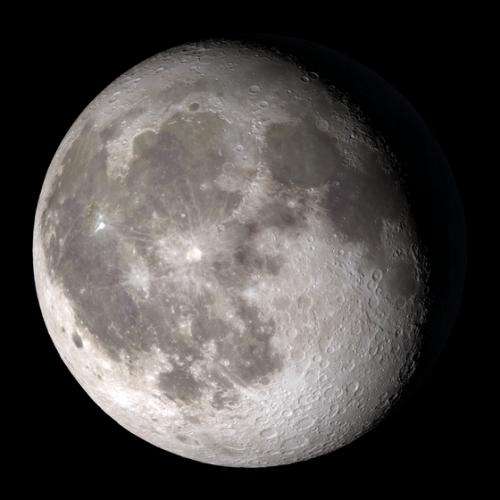New 2013 phases of the Moon animation released

(Phys.org)—A new animation highlighting the phases of the Moon has been released by the Scientific Visualization Studio at NASA Goddard Space Flight Center in Greenbelt, Md.
The animation shows at hourly intervals, the geocentric phase, libration, position angle of the Moon's axis, and apparent diameter of the Moon throughout the year 2013. Topographic measurements by the Lunar Orbiter Laser Altimeter aboard the Lunar Reconnaissance Orbiter make it possible to simulate shadows on the Moon's surface with unprecedented accuracy and detail.
"Thanks to Lunar Reconnaissance Orbiter, we now have excellent terrain maps of the Moon that can tell us the elevation at any point on the surface," said Ernie Wright, author of the new video from the Scientific Visualization Studio (SVS). "I use those maps to make the Moon sphere bumpy in all the right places. That allows the rendering software to realistically simulate all the shadows and the ragged terminator (the dividing line between day and night)."
The SVS uses the same software that Hollywood uses to create 3D animations and special effects. The software allows Wright to arrange virtual cameras, lights, and objects into a scene for rendering.
Wright started out by calculating the position of the Earth and the direction of the Sun for every hour of the year. He then wrote the program that tells the animation software to put the camera where the Earth is and to point the light in the same direction from which the Sun is shining. The Moon is motionless at the center of the scene as the camera and light fly around, according to Wright. Every frame of the animation represents an hour, and the program sets the positions and directions at each frame.
The Moon always keeps the same side to us, but not always the same face. Because of the tilt and shape of its orbit, Earth observers see the Moon from slightly different angles over the course of a month. When a month is compressed into 24 seconds, as it is in this animation, the changing view of the Moon makes it look like it is wobbling. This wobble is called libration.
The most noticeable monthly variation in the Moon's appearance is the cycle of phases, caused by the changing angle of the Sun as the Moon orbits the Earth. The cycle begins with the waxing (growing) crescent Moon visible in the west just after sunset. By first quarter, the Moon is high in the sky at sunset and sets around midnight. The full Moon rises at sunset and is high in the sky at midnight. The third quarter Moon is often surprisingly conspicuous in the western sky long after sunrise.
Celestial north is up in these images, corresponding to the view from the northern hemisphere. The descriptions of the print resolution stills also assume a northern hemisphere orientation. To adjust for southern hemisphere views, rotate the images 180 degrees, and substitute "north" for "south" in the descriptions.
More information: To see this new video and for additional resources visit: svs.gsfc.nasa.gov/goto?4000
Provided by NASA
















